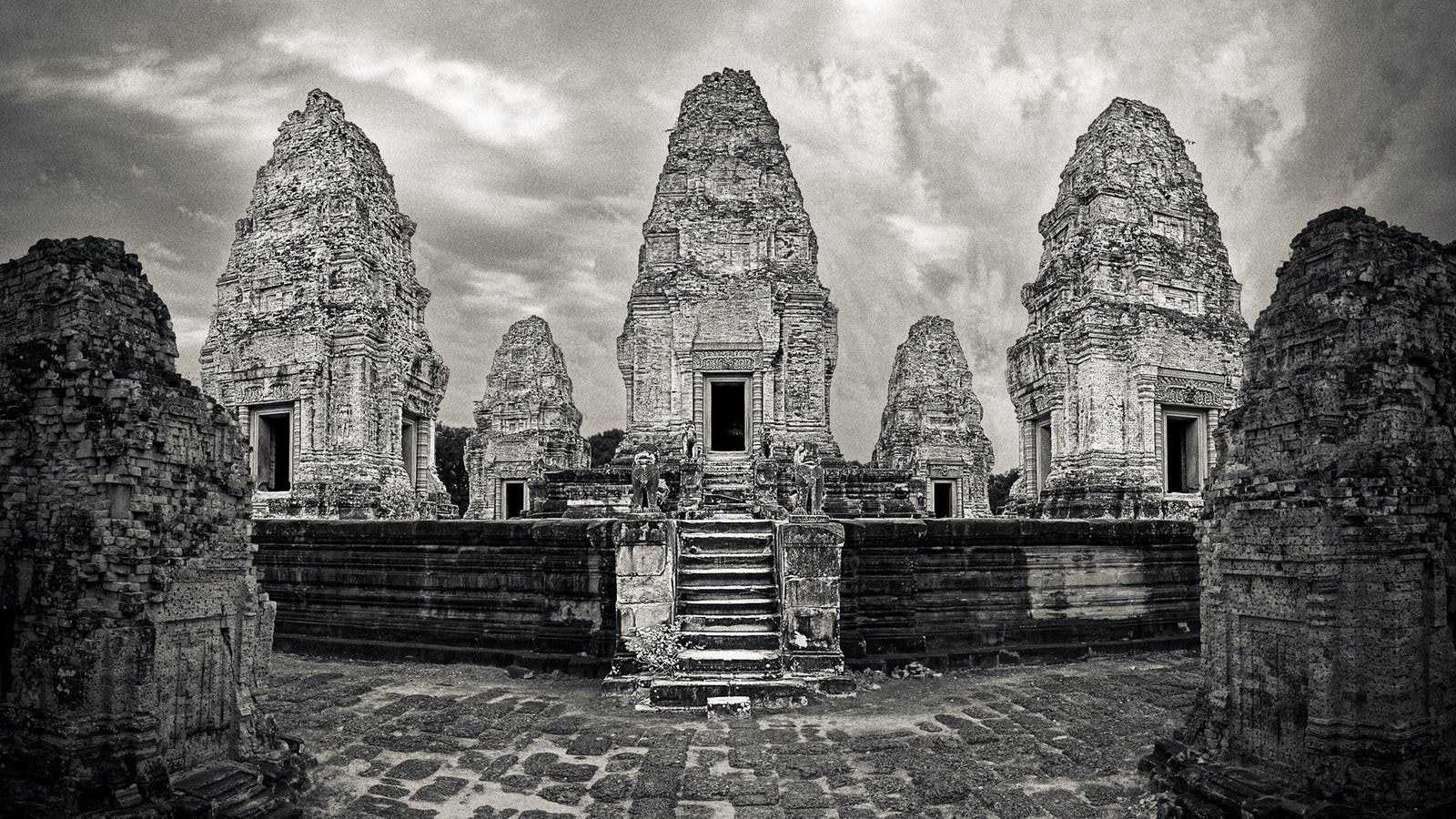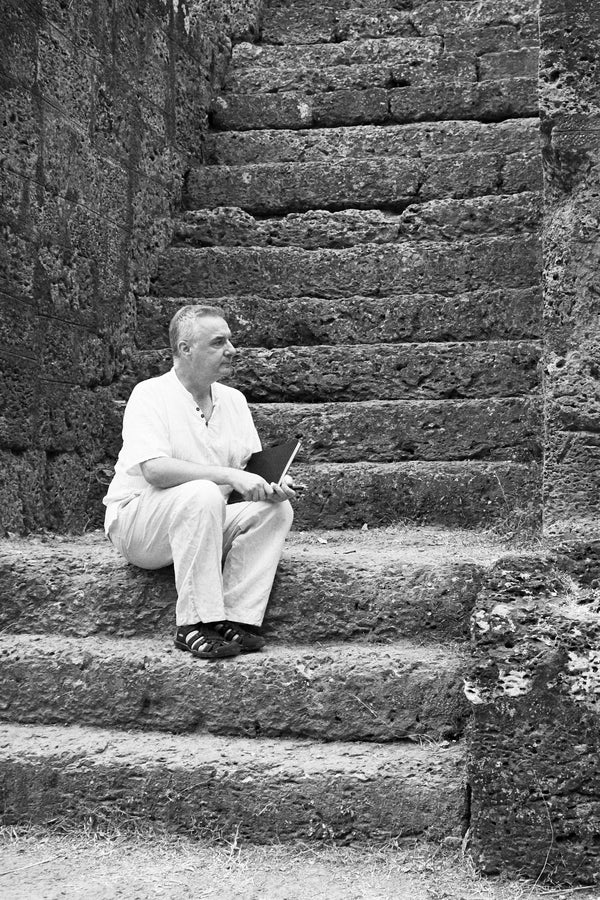Complimentary worldwide shipping on orders over $400 · No import tariffs for most countries
Complimentary worldwide shipping on orders over $400 · No import tariffs for most countries

East Mebon Temple
2 min read
| Date: | 10th century CE (953 CE) |
| Style: | Pre Rup |
| King: | Rajendravarman II (reign 944 – 968 CE) |
| Cult: | Hindu (Shaivism and cult of the ancestors) |
| Map: | Eastern Mebon Temple, Krong Siem Reap, Cambodia |
The East Mebon (Khmer: ប្រាសាទមេបុណ្យខាងកើត) is a huge temple with five flamboyant towers arranged in a quincunx, built by Rajendravarman II to honour the memory of his parents.
The temple's architect, Kavindrarimathana, Buddhist minister and guru of Rajendravarman II, is the only Angkor architect whose name is known to us. He also built Bat Chum Temple, his private foundation, and Srah Srang.
Located in the centre of the, now dry, East Baray (the Yashodharatataka built by Yashovarman I), the intrepid traveller Helen Churchill Candee imagined how the temple must have looked when the baray (reservoir) was full:
“Could any conception be lovelier, a vast expanse of sky-tinted water
as wetting for a perfectly ordered temple.”
East Mebon has the trademark Angkor quincunx-tower arrangement and temple-mountain profile (see below), yet maintains traditional Indian-inspired square-plan sanctuaries. It stands on the cusp of an entirely unique Khmer style that would begin fifty years later, at the very start of the 11th century CE.
East Mebon has a pyramid structure consisting of three tiers. Guarding the corners of the first and second levels are beautifully sculpted elephants (the best one is in the southeast corner).
The inner enclosure contains eight smaller towers and skilfully carved lintels upon the gopuras featuring Lakshmi being watered down by two elephants and Vishnu in his man-lion avatar, Narasimha.
The upper terrace contains the five towers, the northwest tower features Ganesha riding his own trunk; the southeast tower shows an elephant being eaten by a monster and the central sanctuary’s lintels depict Indra on his mount and Varuna the guardian.
The East Mebon and Pre Rup Temple were the last monuments in plaster and brick; they mark the end of a Khmer architectural epoch. The overall temple construction utilises all materials that were available at the time: plaster, brick, laterite and sandstone.
Although many believe East Mebon to be a temple-mountain, that wasn’t its original intention, it just appears that way now that surrounding waters have disappeared. Instead, it was built on elevated ground that was an island in the middle of the East Baray. This island-temple reinforced the symbolic purpose of the baray in Khmer religious life, representing the seas of creation that surround Mount Meru, represented by East Mebon, home of the Hindu gods.
Sanctuary Above the Sacred Waters
Photographs from East Mebon – Spirit of Angkor series by Lucas Varro
Once surrounded by the now-vanished waters of the East Baray, East Mebon rose like an island-temple—its towers reflections of the divine cast upon a vast, sacred reservoir. Though the waters have long receded, the temple still holds the memory of stillness, of vast sky mirrored in stone, of elephants standing guard over the turning of centuries.
Dedicated to Shiva and built upon a quiet axis of reverence and ascent, East Mebon offers not spectacle, but serenity. Light here moves with grace, washing over worn sandstone lions and weathered devatas with the hush of something remembered.
In this collection, Lucas Varro brings his analogue cameras to the elevated quiet of East Mebon. Each image—captured on black-and-white film and shaped through long exposure, chiaroscuro, and hand-toning—evokes not only the form of this sacred place, but the spirit that breathes within it. A solitary guardian in early light. A meditating figure cradled by time. The echo of water where none remains.
Printed in limited edition on museum-grade Hahnemühle Bamboo paper, each photograph is accompanied by a Collector’s Print Package including poetic writings, curatorial insights, and reflections drawn from the artist’s solitary field visits.
This is East Mebon as it exists in stillness—an island of stone, suspended in memory and light.
Join My Studio Journal
Receive occasional letters from my studio in Siem Reap—offering a glimpse into my creative process, early access to new fine art prints, field notes from the temples of Angkor, exhibition announcements, and reflections on beauty, impermanence, and the spirit of place.
No noise. No clutter. Just quiet inspiration, delivered gently.
Subscribe and stay connected to the unfolding story.

Join My Studio Journal
Receive occasional letters from my studio in Siem Reap—offering a glimpse into my creative process, early access to new fine art prints, field notes from the temples of Angkor, exhibition announcements, and reflections on beauty, impermanence, and the spirit of place.
No noise. No clutter. Just quiet inspiration, delivered gently.
Subscribe and stay connected to the unfolding story.


